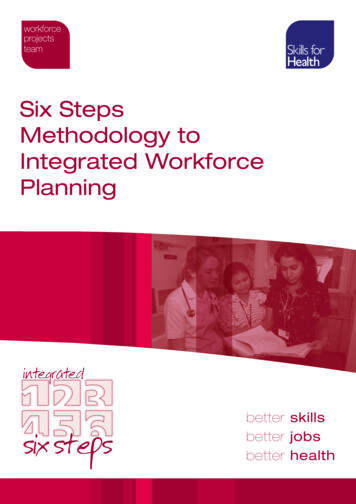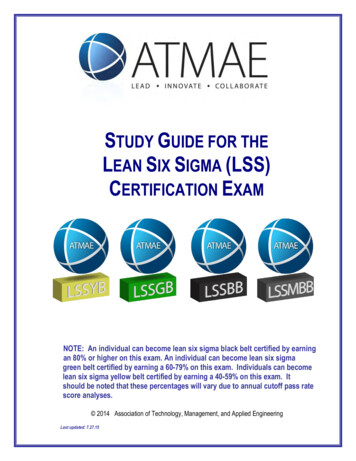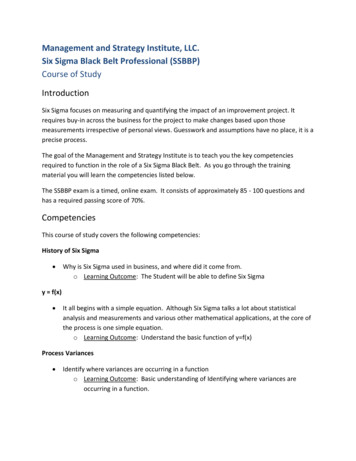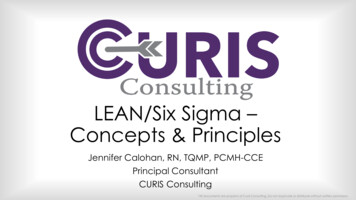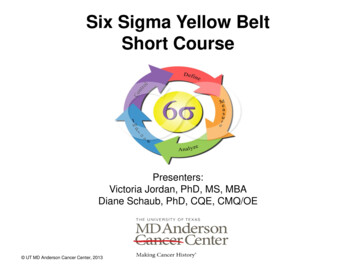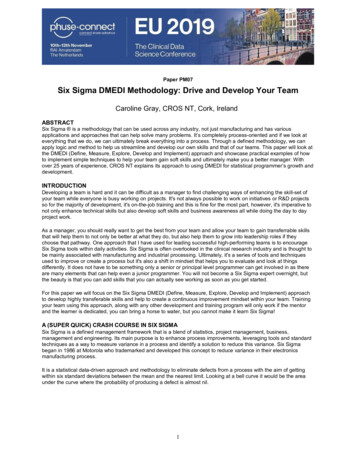
Transcription
Paper PM07Six Sigma DMEDI Methodology: Drive and Develop Your TeamCaroline Gray, CROS NT, Cork, IrelandABSTRACTSix Sigma is a methodology that can be used across any industry, not just manufacturing and has variousapplications and approaches that can help solve many problems. It’s completely process-oriented and if we look ateverything that we do, we can ultimately break everything into a process. Through a defined methodology, we canapply logic and method to help us streamline and develop our own skills and that of our teams. This paper will look atthe DMEDI (Define, Measure, Explore, Develop and Implement) approach and showcase practical examples of howto implement simple techniques to help your team gain soft skills and ultimately make you a better manager. Withover 25 years of experience, CROS NT explains its approach to using DMEDI for statistical programmer’s growth anddevelopment.INTRODUCTIONDeveloping a team is hard and it can be difficult as a manager to find challenging ways of enhancing the skill-set ofyour team while everyone is busy working on projects. It's not always possible to work on initiatives or R&D projectsso for the majority of development, it's on-the-job training and this is fine for the most part, however, it's imperative tonot only enhance technical skills but also develop soft skills and business awareness all while doing the day to dayproject work.As a manager, you should really want to get the best from your team and allow your team to gain transferrable skillsthat will help them to not only be better at what they do, but also help them to grow into leadership roles if theychoose that pathway. One approach that I have used for leading successful high-performing teams is to encourageSix Sigma tools within daily activities. Six Sigma is often overlooked in the clinical research industry and is thought tobe mainly associated with manufacturing and industrial processing. Ultimately, it's a series of tools and techniquesused to improve or create a process but it's also a shift in mindset that helps you to evaluate and look at thingsdifferently. It does not have to be something only a senior or principal level programmer can get involved in as thereare many elements that can help even a junior programmer. You will not become a Six Sigma expert overnight, butthe beauty is that you can add skills that you can actually see working as soon as you get started.For this paper we will focus on the Six Sigma DMEDI (Define, Measure, Explore, Develop and Implement) approachto develop highly transferable skills and help to create a continuous improvement mindset within your team. Trainingyour team using this approach, along with any other development and training program will only work if the mentorand the learner is dedicated, you can bring a horse to water, but you cannot make it learn Six Sigma!A (SUPER QUICK) CRASH COURSE IN SIX SIGMASix Sigma is a defined management framework that is a blend of statistics, project management, business,management and engineering. Its main purpose is to enhance process improvements, leveraging tools and standardtechniques as a way to measure variance in a process and identify a solution to reduce this variance. Six Sigmabegan in 1986 at Motorola who trademarked and developed this concept to reduce variance in their electronicsmanufacturing process.It is a statistical data-driven approach and methodology to eliminate defects from a process with the aim of gettingwithin six standard deviations between the mean and the nearest limit. Looking at a bell curve it would be the areaunder the curve where the probability of producing a defect is almost nil.1
SIX SIGMA DMAICThe typical Six sigma approach utilizes a DMAIC (Define, Measure, Analyse, Improve and Control) methodologywhich is heavily data-driven and statistical in nature. It is used when a product or process already exists but iscurrently under-performing or needs to be improved. This is primarily used in manufacturing and where there arehighly automated processes that can be easily measured. This approach is highly effective and can be usedanywhere a current process needs to be improved, for example, at CROS NT, we utilized this approach to decreasethe processing time of our standard table macros.Created using Bizagi Modeler 3.3.2.033DESIGN FOR SIX SIGMAA less rigid and more innovative way of using Six Sigma would be to use a DFSS (Design for Six Sigma) approach.Unlike DMAIC, DFSS is used when designing a new product or process and can be adapted more to what you needas it's an approach more than a methodology. There are multiple variations of this model and it shares some of thesame steps as the DMAIC model, however, it can be adapted easily to fit your purpose. DFSS is an approach thathas quantifiable data and proven design tools that allow a proactive approach to designing a new process/service.We will focus on DMEDI methodology for the purpose of this paper and there is a link to additional material in therecommended reading section. The below flowchart can be used to decide if a traditional DMAIC or a DFSSapproach is best for your process /service.2
Created using Bizagi Modeler 3.3.2.033DESIGN FOR SIX SIGMA DMEDI APPROACHDMEDI is a five-step process that uses a DFSS approach to break down and build new processes based on theanalysis of needs and preferences. As this is less rigid than DMAIC, it is more suitable to Clinical StatisticalProgramming as we rarely have anything that is truly automated and there is a lot of customization in everything thatwe do. We will focus on these five steps: Define, Measure, Explore, Develop and Implement. It's all about the endcustomer and designing exactly what they are looking for and providing the best customer experience.Created using Bizagi Modeler 3.3.2.0333
HOW CAN SIX SIGMA HELP A TEAM?Each phase of the DMEDI process has standardized tools and techniques that can be used across any industry.Having a knowledge of how to use these and some practical experience will help you to understand the concepts andstart changing the way we look at problems. You probably already approach problems using elements of Six Sigmawithout even realizing it but when you put it all together, it becomes a powerful tool in creating leaner processes.There are many training courses in Six Sigma and a number of these are short courses that introduce the conceptsbut there is nothing like getting your hands dirty and delving right in, start using the tools, understand the techniquesand watch as your knowledge grows in business, analytical and quality direction.If you can get your team involved with learning and applying the methodologies of Six Sigma, this can have anincredible impact on business understanding and analytical abilities for the individual. Factor in the intrinsicmotivational benefits, job enrichment and empowerment that this role expansion provides, and you have a recipe forsuccess. As a manager you also reap the benefits of the team thinking differently and looking for ways to continuallyimprove current processes and thinking with a leaner mindset. Six Sigma can also prepare your team for leadershiproles as there are elements of driving initiatives, quantifying financial benefits and being accountable for quality. Theskills learned are somewhat standardized so are highly transferrable to other roles. It's a win-win situation for yourcompany, for you as a manager and your team members.WHY THIS WOULD WORK FOR STATISTICAL PROGRAMMERSWorking within Statistical Programming is a unique environment, traditional pathways of learning may not be of keeninterest or relevance to true growth. How many Statistical Programmers do you know that will jump at a chance to doanother training on communication styles? Not to generalize but, Statistical Programmers are technically focused, welike working with data, we like statistics and we like a certain methodical and structured element to everything that wedo, even learning. In the end, we like to see results and fast.As your team progresses through their careers, there will also be more requirement to understand the businessaspects of their roles and seeing the bigger picture. When you put this all together, it's a lot of different directions togain skills in and it can be difficult to focus on the right ones. With this in mind, it can be challenging to find somethingthat fits the bill, we need a methodology that will challenge and drive personal growth that encompasses statisticallytechnical competencies, soft skill elements and business acumen and all while doing a great job. Six Sigma mayhave some answers.A PRACTICAL EXAMPLE OF DFSS DMEDI IN ACTIONDo a search for Six Sigma and you will soon be overwhelmed with millions of hits, there is a lot of information outthere and no wonder, this methodology has been around since the '80s. It can be difficult to know where to begin butusing a simple practical example we will look at the process to get you started on your Design for Six Sigma journey(DFSS) and explain how these techniques can enhance your teams' skills.First things first, let's find a product/service or a process you want to create or completely re-design.Now that your head has a million ideas about what needs to be created, we need to condense this into somethingmore manageable. We cannot create everything at once so think about which one would add most value right now.Forget the rest, there are plenty of other days to do this all over again.Let's begin by defining the product/service or process that we want to achieve. For the purpose of this paper we willuse a recent example at CROS NT to help solidify understanding. We will reference a number of different Six Sigmatools and techniques, however, for the scope of this paper will not detail them all individually. There is a tableshowcasing some of the more popular tools with additional details and in the reference section there is a link in therecommended reading section to the American Society of Quality where more information on specific tools can beobtained.Project Aim: To develop a new service to create data visualization drill-down reporting4.
DEFINE PHASEPhaseDefineDescriptionDefine the purpose, structure, goals and the value to the team/company. What are thebenefits/challenges/risks?Our first step was to define the scope of the data visualization project, write down all the information that we had andwhere we wanted to get to. We needed to think about what documentation would help us to reach our goals ascorrect planning and documentation at the start of a project dramatically reduces the chances of things going wrongand at least when they do go wrong, you have mechanisms in place to deal with it. We defined what the projectshould involve, a very high-level process of potential inputs and outputs and how we would communicate internallyand with the customersUsing some of the following tools helped us to define the scope of the project and how we expected to handlechallenges, it also ensured that everyone was on the same page:PhaseDefineExample Tools/Techniques UsedProject Charter Suppliers, Inputs, Process, Outputs, Customer (SIPOC) Communication Plan Encouraging the team to try out and develop these techniques and tools allowed for growth in some of the followingskills:Tools/Techniques UsedProject CharterSuppliers, Inputs, Process,Outputs, Customer (SIPOC)Communication PlanSkills GainedHow to draft a project plan and think about the connected elements from different sources, therefore creating a broader understanding ofthe bigger picture.Overview of the project not just from a technical perspective but also the business elementExposure to how project success is measured (objectives/metrics) Help the team define a complex project that is not well scoped from a customer perspectiveGrasp the concept of all elements involved in a process Thinking about the project from all possible team membersperspectives and how these would all work together and communicateeffectivelyDefine solid approaches to document communication and action itemsLearn about escalation pathways and resolving roadblocksMEASURE PHASEPhaseMeasureDescriptionGather the needs of the customer/project and how these can be measuredOur next step was to focus on the needs of the customer and translating them into something measurable. Wewanted to make sure that our service and end data visualization product excited the customer. We needed toconsider if what we were proposing had everything that they needed and also what they might want?Needs and wants are essential to define as clients will usually want everything but only need the bare essentials. Aswe did not already have an end process/service in place this step was critical to ensure that the project was doing theright thing for the end result. Using some of the following tools helped us to gather customer requirements, the moralof the story here is, if you do not know what the end result or service should be, find out, ask the right questions andlisten to the customer.5
PhaseMeasureExample Tools/Techniques UsedVoice of the Customer (VOC) Voice of the Business (VOB) Critical Customer Requirements (CCR) Kano Model We spoke with the customers and asked them what they wanted to do with the data and how they wanted to visualizeit, we delved into this to understand what we needed to implement in order to meet their requirements. It was alsoimportant to assess if this project would be business viable and had stakeholder backing. With the team involved ingathering customer requirements, this helped enhance the following:Tools/Techniques UsedVoice of the Customer (VOC)Skills GainedObjective thinking about customer requirements Client interactions skills Foundation in relationship building Exposure to financial implications Strategic elements as to what is important to CROS NT from a project perspectiveIdentify the four areas relating to customer satisfaction Develop skills in asking the right questions Negotiation of wants versus needs for a customer Create a customer-centric approach to projects/services Develop psychology related technique to meet customer requirementsVoice of the Business (VOB)Critical CustomerRequirements (CCR)Kano ModelEXPLORE PHASEPhaseExploreDescriptionExplore a conceptual design of your new process/serviceNext, we conceptualized and investigated our different options available and we explored an approach alongside apotential process. Nothing was created at this time apart from laying out our options. Using some of the followingtools helped us to map out a new process or to come up with some new ideas on how to visualize data:.PhaseExample Tools/Techniques UsedBrainstormingExplore Affinity Diagram Pareto Chart Pugh Matrix Once we had some options in place, we were able to make an informed decision about how to proceed. Using thetools/techniques allowed the team to grow in the following areas:Tools/TechniquesUsedBrainstormingSkills Gained Conducting meetings and establishing ground rulesLeadership skills in driving ideas and collaborationAffinity Diagram Techniques for clustering ideas into tangible resultsDecision makingPareto Chart Critical thinking for evaluating factorsExcel skills6
Tools/TechniquesUsedPugh MatrixSkills Gained Leadership and decision makingIncreased customer understandingDEVELOP PHASEPhaseDevelopDescriptionDevelop a detailed plan on how you are going to organize and implement thisprocess/service at its optimal state.We needed to decide how we would action this project and how we were going to develop this data visualization toolinto something that the client actually wants. Using some of the following tools helped us to develop some ideas,ensuring that the customer requirements were considered and met.PhaseDevelopExample Tools/Techniques UsedDesign of Experiments Failure Mode and Effects Analysis (FMEA) Risk Assessment/Management Plan As the team were heavily involved in this area, they gained knowledge of the following:Tools/Techniques UsedDesign of ExperimentsSkills GainedCause and effect concepts Optimization techniques Failure Mode and Effects Analysis(FMEA) Considering possible failures and mitigating riskExcel skillsRisk Assessment/ManagementPlan Critical thinking regarding project risksEffects on the business/customerIMPLEMENT PHASEPhaseImplementDescriptionImplement the process/service, validate the design and establish controlsThe last step was to implement the project design and the data visualization tool we have come up withPhaseImplementExample Tools/Techniques UsedPilot Control Plan Design Scorecard Once your process/service has been designed and set up, then you can use a DMAIC approach to continuallyimprove it. At the end phase of the project, the team learned the following:Tools/TechniquesUsedPilotSkills Gained Confidence of leading the projectCustomer relationship building7
Tools/TechniquesUsedControl PlanSkills GainedDesign Scorecard Awareness of quality standardsMetrics and KPI's Evaluate design performanceOptimize future performance of a serviceHOW CAN I GET MY TEAM INVOLVED?There are hundreds of tools and techniques for implementing DMAIC or DMEDI that can be transferrable to otheraspects of the business and there is usually something for every occasion. I started learning Six Sigma in 2014 and Istill learn something new every time I read an article, book or journal on the subject. Your team can start learning atany level and the below tables show some of the techniques and advantages for learners at every level. They canbuild on these skills and use them to be more effective at what they do best.JUNIOR LEVEL PROGRAMMERSTool/TechniqueKanbanWhat is it used for?Time Management5 Whys StrategyRoot Cause analysis ofa problemFlow ChartDefine a processvisuallyBrainstormingIdea GatheringDescriptionVisual representation of daily tasksAllows to gain skills in prioritizationHelps identify root cause of a problemChanges mindset in analyzing problemsAllows for a complete understanding of a processCreates a what is the next step mindsetGenerates a large volume of creative ideas in a shortperiod of timeBenefitAbility to manage timeeffectively and take ownership oftasksDescriptionHelps identify root cause of a problemUseful when a team's thinking is in a rutHelps focus on the most significant issues that willadd valueHelps communicate results to othersChanging a process to avoid human errorProcess driven approach and thinkingAllows for bigger thinking on a projectBetter scheduling BenefitUnderstanding of cause andeffectEmpower objective thinking inresolving issues in an effectivemannerSimplify and encourage adeeper understanding ofprocessesBuild leadership skills andexperience of coordinatingothersMID/SENIOR LEVEL at is it used for?Root Cause analysis ofa problemPareto ChartIdentify issues on an80/20 rule - 20% ofissues cause 80% ofthe problemsPoke YokeMistake ProofingGantt ChartsDefines timelines andnext steps withdependencies8Learn what adds the most valueusing the 80:20 ruleEnsuring issues are mitigatedsufficiently so the likelihood ofthem happening is dramaticallyreducedOverview of projects andidentifying dependencies
Tool/TechniqueVoice of theCustomer(VOC)What is it used for?Gather CustomerRequirementsKano modelGather CustomerRequirementsDesignScorecardUsed to document thecurrent status of theproject/service criticalto quality elementsControl PlanFor monitoringrepetitive tasksCommunicationPlanDefines howcommunication willoccur on a projectDescriptionFind out what a customer actually wantsLearn to ask the right questionsUseful to translate customer needs into manageabletasksCreates a thorough understanding ofrequirementsHelps to ensure the project/service is meetingcustomer expectationsChanges mindset to focus on the customerStatistically based evidence ensuring a process isworking properlyCreate awareness of metrics, controls and out ofbounds resultsSets expectations on communication within aprojectDefines roles and responsibilities and createsawareness of otherdepartmentsBenefitEnhancing a customer focusedmindset and relationshipbuildingCreates an understanding oftrue customer requirementsDetermines if the process isworking and the client is happyStatistically based results abouta process that can be sharedwith senior management, yourteam or the customerEnhanced communicationinternally and with customersPRINCIPAL LEVEL PROGRAMMERSTool/TechniqueFMEA AnalysisWhat is it used for?Identify all possiblefailures in a design,process or serviceProject charterDefine a project scopeand requirementsVoice of theBusiness (VOB)Defines stated andunstated needs of thebusinessRiskAssessment/ManagementPlanDefines how risks areidentified and mitigatedDescriptionAllows the associate to think about possible risksGathers a complete understanding of currentprocess/serviceMultiple elements involved in collecting and designinga project flowBusiness acumen and understandingEnsures project/service meets business needsBusiness acumen and understandingCreates business financial awareness Create a risk-basedapproach mindset toprojectsAllows the user to thinkabout the process in adifferent way9BenefitA risk approach mindset beingdeveloped within the teamClear expectations of roles andresponsibilities for a morestreamlined projectStakeholder engagementMitigate risks as much aspossible
Tool/TechniqueDesign ofExperimentsWhat is it used for?Determines cause andeffects relationshipsPugh MatrixFacilitates conceptgeneration andselectionSIPOCTool that summarizesinputs and outputs of aprocessAffinity diagramOrganizes a largenumber of ideas intotheir naturalrelationshipsDescriptionStatistical method of determining effects oninput/outputs of a processChanges mindset of processesTeam leadership skills requiredDevelops leadership skills and decision makingGives a full overview of a process before work beginsCreates a high-level process mappingTurns brainstorming chaos into actionable itemsDevelops leadership skills and decision makingCONCLUSIONBenefitCreates a goal of wanting amore optimized process andcontinually improvingDecision making and criticalthinking developmentThorough understanding ofexternal elements in a processOrganizational skills anddecision makingBy challenging your team to learn new ways of doing things, you can build their expertise and also make it relevantfor a high-performing team. You can create a mindset of continual improvement and allow people to grow their ownskills and all while doing the best job that they can. Six Sigma is not only relevant to so many aspects of the businessthat we are in but it's also interesting to those of us looking for a statistically based approach to doing things better.RECOMMENDED READINGQuality tools for Six Sigma with explanations from Design for Six sigma /design-six-sigma-dfss-versus-dmaic/Keller, Paul (2011) Six Sigma Demystified, McGraw HillCONTACT INFORMATIONYour comments and questions are valued and encouraged. Contact the author at:Caroline GrayCROS NTFairbourne Drive, Atterbury LakesMilton Keynes, MK10 9RG, United KingdomWork Phone: 44 1908 488 787Fax: 39 045 820 58 75Email: caroline.gray@crosnt.comWeb: https://www.crosnt.comBrand and product names are trademarks of their respective companies. indicates USA registration.10
Six Sigma DMEDI Methodology: Drive and Develop Your Team Caroline Gray, CROS NT, Cork, Ireland ABSTRACT Six Sigma is a methodology that can be used across any industry, not just manufacturing and has various applications and approaches that can help solve many pro



